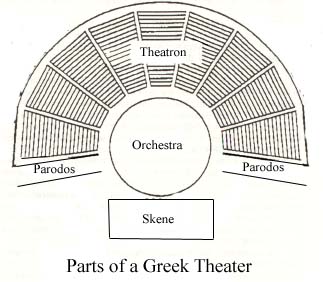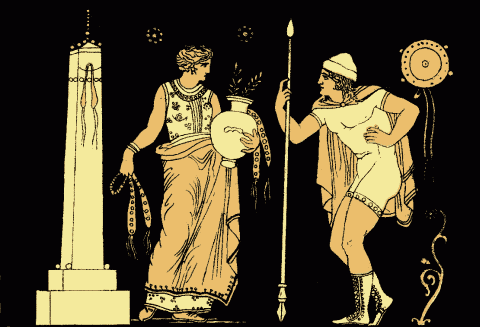How Was The Play Staged and Performed To It's Original Audience?
Electra is an ancient Greek play. There are three different types of Greek plays, comedy, tragedy and satire. Electra is a tragedy. Most Greek plays were based on ancient myths and Electra follows this tradition.
Greek theatres were always outside. The earlier theatres were basically just areas on a hill side but as time went on the designs became more elaborate. Theatres were placed on hillsides so that everyone watching could hear really well. Here is a picture of the layout of the type of theatre that Electra would have been performed in.

The Theatron is where where the audience sat. The word "Theatron" literally translates to "viewing place". They were usually on hillsides overlooking the Orchestra. In the 5th Century BC audience members could bring cushions to sit on but by the 4th Century BC they had marble seating in theatres.
The Orchestra was usually round and is where the chorus would dance, sing and interact with the actors on stage. In the early days of Greek theatre they would have been made out of hard earth, but later on they were sometimes made out of marbel instead. Many orchestras had an altar in the middle as there was a big connection between drama and religion.
The Skene was behind the stage and was a dressing room for the actors. It was also used as scenery and often painted as a palace, temple or some sort of building depending on the play. For example, the Skene in Electra could have been used for the door to the house.
The Parodos were how the chorus and some of the actors entered and exited the stage. It was also the way the audience entered and exited the theatre.
 |
| Another illustration of a Greek Theatre |

Another reason they wore masks was so that audience members at the back could still understand the play and see their facial expressions as they would have been quite far away from the stage. Also, sometimes there would only be 3 actors so they needed different masks to be able to portray different characters. The chorus would all wear similar masks but they would be completely different from the mask worn by the leading role.
What Social, Political and Cultural Themes Were Contained In The Play?
 |
| An ancient drawing of Electra's family |
The whole play is based on the social theme of family and how relationships are strained due to the actions of different family members. For instance, Electra hates her mother for the death of her father, who she stays loyal to even though he sacraficed her sister. Clytomnestra is afraid of her own son, Orestes as she knows he could come back to kill her. This brings us on to the cultural theme surrounding the story of Electra. It was tradition in Greek times for the son to avenge his father, which caused Electra to have to give her brother away, meaning Orestes could not grow up with his family and Clytomnestra lived her life in fear.
There are also political themes of sexism in this play. Why did Electra have to rely on her brother to avenge their father? Why couldn't she have done it herself? She wrestled with these questions herself to some extent, but in ancient greece it was thought that women were to weak to be able to do such a task and it was up to the men to do it.
Are They Meaningful For Both Original And Modern Audiences?
I think the themes of family relationships and gender roles are universal and timeless. Although they may not be as dramatic as they are in Electra's family, everyone has family problems at some point or another so modern audiences can relate to it in that way. Sexism and gender roles is still a major issue today even if its not as bad as it was in ancient Greece.
It would have been meaningful to the original audiences in a different way, as the story is important to their culture so they probably would have already known it when they went to see it, similar to fairy tales today. They would have been able to relate to the cultural themes, such as the son's duty to avenge his father as it was something that was prominent in their culture at the time.
The fact that it is still in theatres today shows how meaningful the story still is today.


How Did You Tackle The Play's Language Practically?
When I first read through the script I didn't really understand a lot of it, so I went online to try and find a modern translation. I tried a couple of well known ones such as Sparknotes but didn't find them very helpful. I then found one called poetryintranslation.com which had a very similar version to our script completly translated into modern language! We had cut down ours a lot so I did need to try and work out what wasn't included in ours but as soon as I started reading it, it started making sense! It also allowed me to work out some things by myself. I then wrote the translation on my script next to the lines I really struggled with, however the only problem with this is not to get muddled up with which version to say. If I still wasn't sure on some words I would ask others in the class or my teacher.
Here is a link to the website: http://www.poetryintranslation.com/PITBR/Greek/Electra.htm
What Did You Do To Ensure You Were Fully Appreciating The Context Of The Play?
 |
| Our Skene. Some of the audience sat on the sides of the stage to create a performance in the round |
In our performance of Electra we staged in the round to reflect the traditional Greek theatres. We also created our own Skene. As for the performance side of things, it was traditional to use over the top movements and convey loud extreme emotion whilst addressing the whole audience. We had a chorus who acted as narrators, dancing and singing to the audience. Dance and song was another tradition of Greek theatre.
What Vocal And Movement Skills Did You Create In Your Performance?
Because our performance was in the round we had to make sure we were addressing all sides of the audience. This caused us to move around the stage a lot more than we might do in a standard modern play. For instance, when I was talking to my sisters, each chorus member went to a corner of the stage and I spoke each line to one of them. In my speech when I am angry with my sisters I start off low and quiet and become faster, louder and crazier as the speech goes on. The chorus tries to restrain me and I start to crawl up the steps. This movement and vocal skills together portrayed how angry and insane my character was.
What Were Your Intentions For Your Character?
I played the role of Electra in Act 2. In this scene she is lead to believe that Orestes is dead. Not only does this mean she has lost her younger brother but she also now has no hope of avenging her father, the one thing she has been set on for years. I believe she would have felt deep grief, agony and shock at the news. When her sisters arrive enthusiastically to tell her they thought they saw signs of Orestes at their father's grave, Electra goes into a rage. She is angry at them for being so positive at this upsetting time for her but obviously they don't know what has happened. Electra is their older sister, but instead of looking after them and being a role model, she is bitter and patronizing towards them. I think this is because she resents them for still living in the palace her mother.
Did You Tackle Your Role With Confidence?
I feel that I did tackle this role with confidence. It wasn't always easy but I pushed myself and brought out different sides to me that I didn't know I had. I worked really hard to learn the lines and once I did that was when I really started to feel comfortable in the role and be confident in my performance.
No comments:
Post a Comment